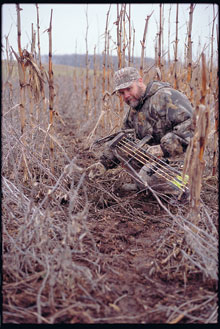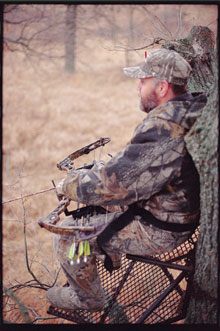October 28, 2010
By Don Higgens
Great Stand Placement Doesn't Guarantee A Buck On The Ground.
By Don Higgens
 In-season scouting is fine, to a certain extent. Crashing through timber and bumping deer from their beds is one of the worst mistakes you can make. Try to limit in-season scouting to walking field edges and long-distance glassing. |
I am fortunate to have a job that puts me out in good whitetail habitat on almost a daily basis. Besides owning a tree farm where I grow shade and landscape trees, I am also a tree planting contractor for various conservation projects. Each spring I plant tree seedlings on a number of sites, most of which are privately owned lands that have been enrolled in conservation programs such as CRP and WRP.
This past spring, I was once again planting seedlings in a prime deer area when I mentally noted two promising locations for tree stands. As my work brought me closer to these potential stand sites, I noticed that another hunter had also discovered these travel corridors and already had his tree stands in place. As I continued to work in the area, it dawned on me that this was not the first time that I had spotted a location that I thought was a prime spot for a tree stand and upon further investigation found that there was already a stand in place. These incidents have not only happened while I was doing these tree plantings, but have also happened a number of times over the years as various other activities brought me into good deer habitat.
Advertisement
A thought really hit home with me that day. It became clear that most hunters are actually pretty good at stand placement. I have seen a number of stands hung by others that I would feel confident hunting from if conditions were right. As I thought about it more, I wondered why more hunters did not kill monster whitetail bucks when so many of them are seemingly adept at stand placement. As I continued to dwell on the matter, a number of other reasons came to mind as to why many hunters fail to realize the potential of their hunting areas when hunting from well chosen stand sites. Here is what I consider the most common mistakes that hunters make to ruin otherwise good stand sites.
Play The Wind
Advertisement
Failure to consider wind direction is likely the primary downfall of many hunters. Nothing can ruin a great stand site faster than hunting it with a bad wind. Successful veteran hunters have preached this for decades, but still a lot of hunters fail to heed the advice. This is likely due to the fact that many hunters simply do not appreciate how keen a whitetails nose actually is and how seriously a mature buck takes a slight hint of human odor. Whitetails in general, and mature bucks in particular, will respond to odors the same way that you respond to sights. A buck standing 100 yards downwind of your stand smelling a hint of human odor isn't going to come marching past your location any more than you are going to follow four masked men carrying guns into a bank. You will back away and wait to make your deposit on another day. The buck will back away and change course and possibly his destination as well. What's more, he will remember the incident and be much less likely to come through the area for some time, probably for the rest of the hunting season. At the very least he will be a lot more cautious and likely scent check the area from downwind before passing through.
Every good stand will have certain wind directions that allow for good hunting as well as others that will not. I have had hunters tell me that they have stands that they can hunt with any wind because the deer show up from any direction. My response is simple. That stand is not in the right location. You cannot give up the wind and hope to have consistent success with mature bucks. It will never work and nothing will ruin a good stand faster than hunting it with the wrong wind.
 Typically, the first time a stand is hunted is the best time to arrow a mature buck. The author chooses to leave his best stand sites alone until the rut kicks in. This allows the author to hunt fresh stands throughout most of the breeding season. |
Sneak In, Sneak Out
Another mistake that hunters make to ruin a good stand site is the route they take to and from their stands. They seem to think that the key to success is the location of their stand, period. A good stand also has a good entrance and exit route. Often this route is not the shortest or easiest path to the stand, but instead requires a longer walk and more effort. Many seemingly good stand sites actually turn out to be duds when the approach route is considered. You must be able to get to your stand without nearby deer seeing, smelling or hearing you. To be successful, an archery hunter needs to hunt deer that are calm and relaxed. These are deer that will be moving naturally and comfortably. This is especially true when hunting for mature bucks.
Getting to your stand unseen often means taking an out of the way route where you are not likely to encounter deer. It also often requires utilizing terrain features such as ditches, swales and other depressions to keep a low profile as you travel to your stand. A good entrance route also allows you to access your stand without your scent blowing into areas where you expect deer to be. Spooking deer before you get to your stand is a sure-fire way to decrease your odds of success in a big way. Be sure and set your stands so that the favorable wind that you need to hunt those stands is also the same wind needed to access it. Finally, your approach needs to be quiet. Stomping through a carpet of dried leaves can kill game activity near your stand for several hours. A much better option is to follow the soft banks of a creek or another quiet path.
Fresh Stands
If you have thought things out and have a plan to access and hunt your stands with specific favorable winds, you could still doom your chances of success by over hunting them. It is a natural tendency for any of us to keep going to those stands that keep producing deer sightings. We give ourselves a false sense of security by thinking that since we are still seeing deer, everything must be fine. This is seldom the case. It is a well accepted opinion amongst successful trophy whitetail hunters that the first time you hunt a stand is the best time to kill a mature buck from it. With every subsequent hunt your odds of success go down rapidly. I firmly believe in this theory and will often leave stands alone until specific periods during the season. For example, I have stands that I save just for the rut and even some that don't get hunted until the late season. This allows me to continually hunt fresh stands throughout the season.
It is tempting to think that only a couple of hunts during the early season won't hurt anything, but I have come to learn otherwise. Just last season this point was hammered ho
me to me. On the evening before firearms season opened, I was hunting from one of my favorite stands situated along the exit route of a prime bedding area. For the last hour of daylight, a buck within the cover was making a nuisance of himself with some does and fawns. He chased them around within the cover grunting almost continually. I caught a couple of glimpses of him through the brush and noticed long tines angling forward on his ivory rack. I suspected that he was the same big buck that I had jumped from another nearby stand a couple of weeks before. The does finally had enough of the would-be Romeo and came past my position with plenty of shooting time remaining. I just knew that it was only a matter of time before the big boy followed. I knew he was still in the brush as I could hear him and occasionally even get a quick glimpse of him through branches and brush. Fifteen minutes later I started getting nervous as the sun began to set and the does moved farther and farther away. I fished out my grunt call and hoped to get the brute to thinking that another buck was now courting his lady friends. It didn't work. The buck remained in the thick cover until it was too dark to shoot. I finally slipped away wondering just how big he really was. The next morning, as firearms season was just minutes old, my friend Henry Hortenstine killed a giant 15-point buck from a nearby stand. That brute gross scores over 190. I am fairly certain that it is the same buck I saw in the thick cover the evening before. As I think back over that experience, I firmly believe that this buck knew the exact location of my stand; probably because I had hunted in it a few times earlier in the season. While I am genuinely happy for Henry, having a buck of that caliber so close and not closing the deal is a good way to remember this lesson for a long time.
Over-Scouting
Another big mistake that archery hunters make is they continually stomp about their hunting area throughout the season under the guise of "scouting." Now I am not denouncing the benefits of in-season scouting. It is certainly a valuable tool in some cases. However, for an experienced hunter in an area that he has hunted for years, stomping through the area is counter productive. In this situation a hunter should already know all that he needs to in order to succeed. The travel routes of the local deer are not going to change much from year to year barring any major changes within the habitat. Stands should be set well in advance of the hunting season and the area then left undisturbed. It really doesn't matter if you see big rubs or other sign in your area. Waltzing through your hunting area will do nothing positive for your chances if you are already familiar with the area. It will do a lot to cut your odds of success, however. Every time you walk through your hunting area you will leave human scent. You will also likely jump deer and in general put the local herd on alert. A mature buck will put up with very little of this. He demands seclusion, and if he doesn't find it on your property, he will go elsewhere. That is a fact that you can take to the bank.
Conclusion
If you are hunting in a good area but are not having the success that you desire on mature bucks, the problem is likely not stand placement. As I stated before, I believe the majority of archery hunters are pretty adept at choosing good stand locations. Instead, look at some of these other variables. You are likely a lot closer to killing more big bucks than you realize. Tweaking your approach a little may be all that is needed. You are probably already in the right spot.
Editor's note: Signed hardback copies of "Hunting Trophy Whitetails in the Real World" can be purchased online at higginsoutdoors.com or by sending $23 plus $5 shipping and handling to Don Higgins, Rt 1 Box 271, Gays, IL 61928.
